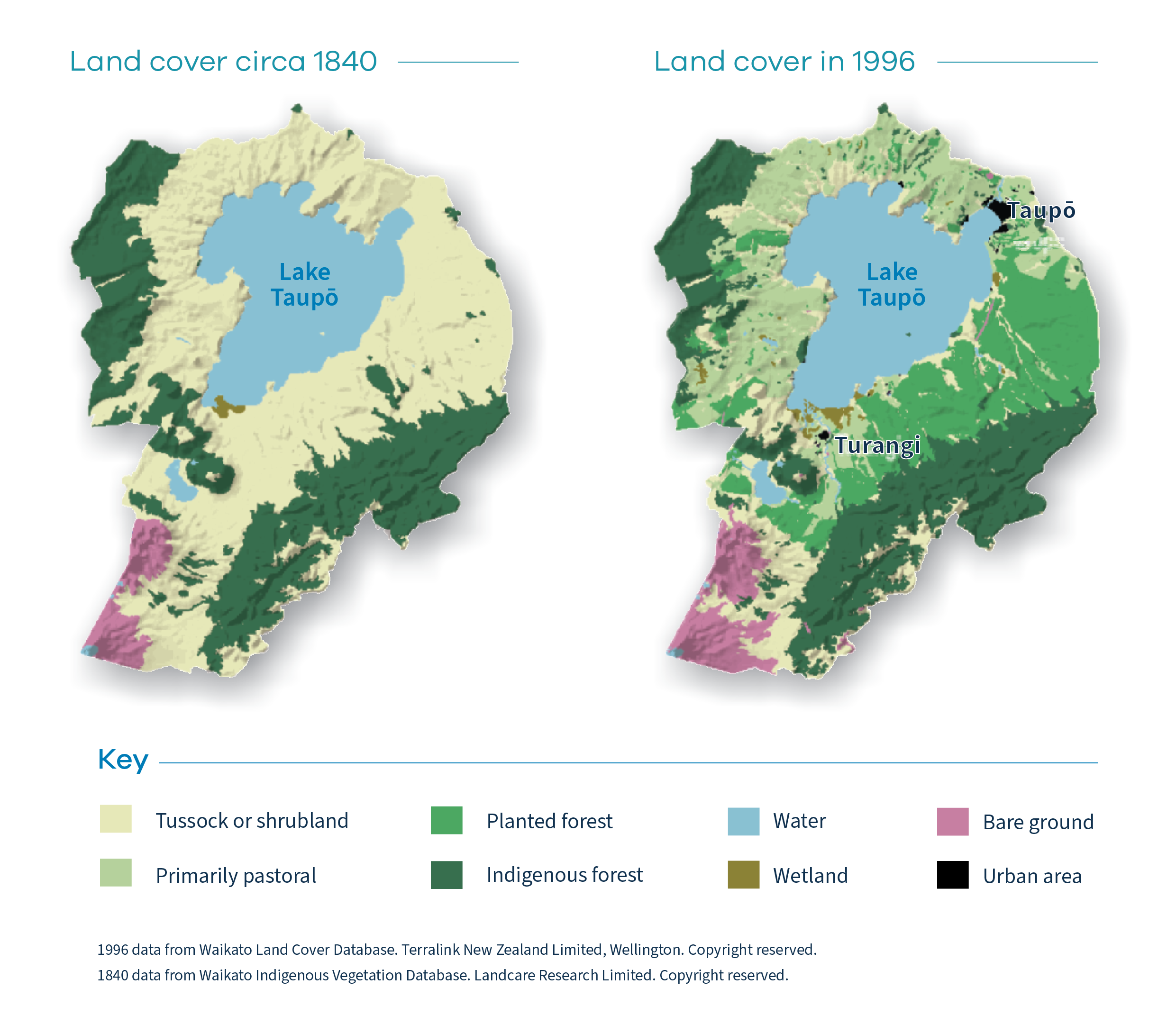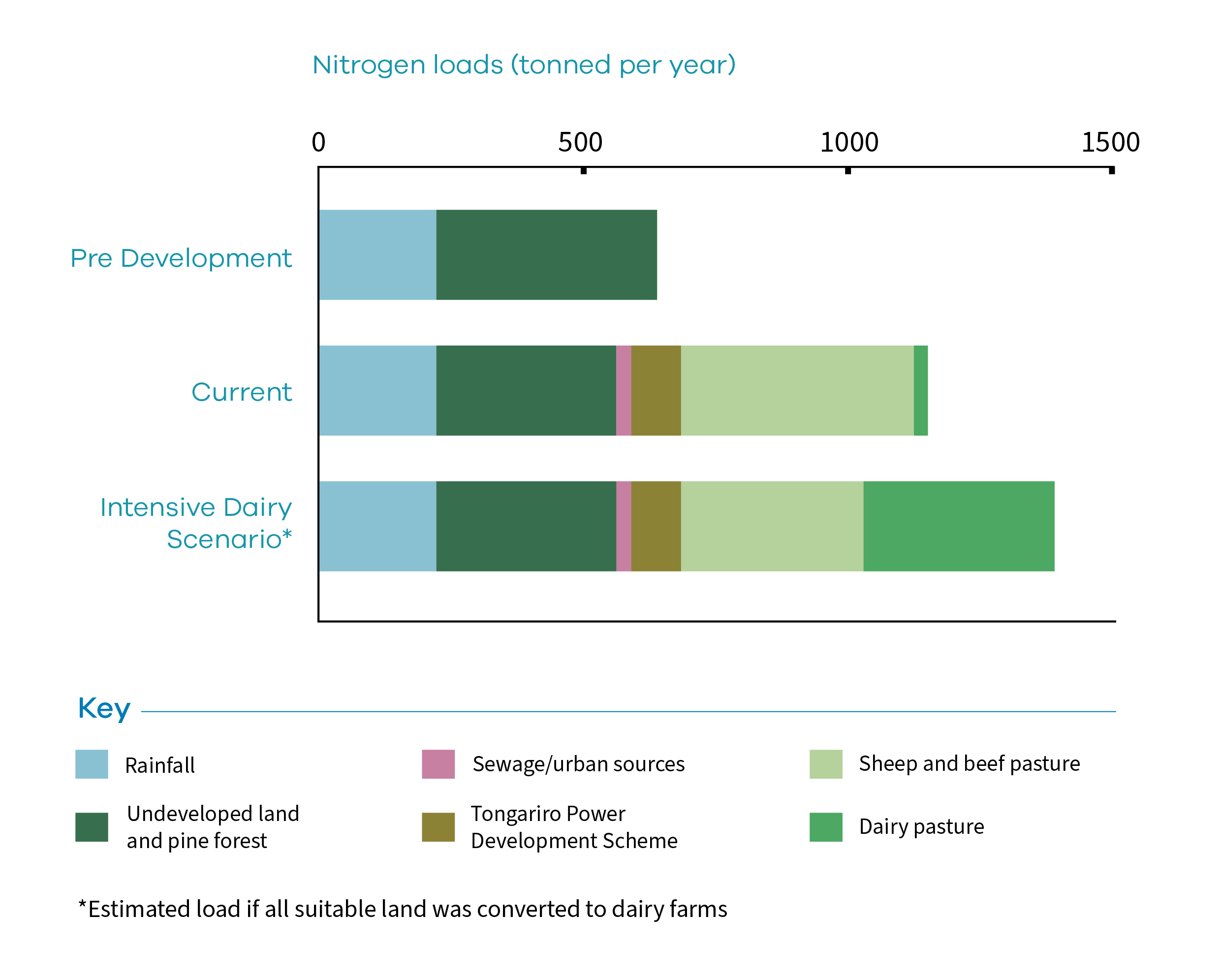How land use affects Lake Taupō
Development of land for agriculture, forestry and urban development over the last 50 years has lead to increasing amounts of nitrogen entering Lake Taupō. While the lake is a complex and sensitive system, long term monitoring indicates that these changes are threatening the lake’s excellent water quality.
Key points
- We have good information about the current sources of nitrogen and phosphorus to the lake. The amount of nitrogen entering the lake from rural and urban sources has increased considerably over the past 50 years.
- Recent scientific bioassay experiments confirm that Lake Taupō is sensitive to nitrogen - algae growth in the lake water increases in response to more nitrogen.
- Trends in several key water quality measures indicate that lake water quality is gradually worsening.
- Modelling indicates that if nitrogen loads to the lake from pastoral agriculture continue to increase, water clarity could visibly reduce.
- Lake Taupō is a complex and sensitive system. Lake water clarity varies considerably from month to month and between seasons.
- It takes a long time for the effect of intensifying land use to be seen in the lake. This is partly because the groundwater that carries much of the nitrogen from the land can take many decades to reach the lake.
- Even if land use in the catchment, and its associated nitrogen loading, stay at the same level as today, monitoring indicates that lake health will worsen.
- Similar lakes overseas have shown dramatic reductions in water quality as a result of intensifying land uses in their catchments.
Taupō’s changing catchment
The images show how land cover has changed in the lake’s catchment since 1840.
The three major changes in the catchment have been:
- loss of tussock or shrubland and indigenous forests
- an increase in planted forests
- an increase in areas used primarily for pastoral agriculture.

Increased nitrogen in lake water
A recent review of monitoring data from the past 30 years indicates that the lake’s water quality is gradually worsening. Scientists are concerned about:
- an increase in chlorophyll a (an indicator of the amount of tiny, free-floating algae) in the Lake’s surface waters between 1994 to 2004
- an associated increase in the particulate forms of the nutrients phosphorus and nitrogen in the Lake’s surface waters between 1994 and 2004
- an increase in nitrate nitrogen in the bottom waters of the lake just prior to winter periods, when the Lake’s cooler bottom waters mix with surface water. Between 1974 and 2004, the amount of nitrate nitrogen doubled.
Nitrogen is a plant nutrient. Increases in nitrogen cause increased growth of tiny, free-floating algae (phytoplankton). More algae in the water reduces water clarity.
Where the nitrogen comes from
The increasing nitrogen probably comes from changes in land use around Lake Taupō such as:
- intensive farming
- more development in towns and smaller settlements.
Nutrient loads in several streams draining farmed areas have increased over the past 20 to 30 years (see the figure below).Recent scientific experiments confirm that Lake Taupō is sensitive to nitrogen. This means that microscopic algae in the Lake respond to even small increases in nitrogen in the lake’s water.
What could this mean for the lake’s future?
Even if land use in the catchment, and its associated nitrogen loading, stay at the same level as today, monitoring indicates that the lake’s health will worsen. There is already a need for management action to reduce the effects of current land use.
The figure to the right shows the amount of nitrogen entering the lake each year from different land uses. The area of the catchment in each land use, multiplied by the amount of nitrogen leaked per hectare by each land use, tells us the current nitrogen load to the lake.
If land use continues to intensify, the threat to the lake will be even greater. Presently, only 10 square kilometres of the total catchment (about 2800 square kilometres) is in dairy farms. About 100 square kilometres of existing sheep and beef pasture could be converted to dairy farming.
The intensive dairy scenario in the figure shows that if all of this land was converted to dairy farms, the future nitrogen load to the lake would be more than 20 percent higher. Science models predict this would reduce water clarity by about 20 percent.

Changes happen slowly
Changes within the lake happen slowly because:
- it takes about 11 years for water to move through Lake Taupō
- groundwater transporting much of the nitrogen from the land is stored underground for several decades before flowing into the lake.
This means that changes are hard to see. It also means that effects of changes in land use may be hard to reverse.
Lake Taupō is a complex and sensitive system. The lake’s water clarity varies considerably from month to month and between seasons. However, based on overseas experience and lake modelling, scientists believe that if past trends of increasing algae growth continue, significant changes in water clarity will occur.
Weeds and algae in Lake Taupō
There are three main types of nuisance plants in Lake Taupō:
- Dense beds of introduced macrophytes (larger underwater plants), such as oxygen weeds. These are the most common types of nuisance plants in the Lake.
- Blooms of filamentous green algae (green ‘cottonwool’), which are sometimes washed up on beaches.
- Slimes of diatoms and other algae in shallow water.
Larger water plants
There are several things that influence the growth of the larger underwater plants:
- Wave action – larger water plants only grow in sheltered areas.
- Water depth – most types of nuisance plants only grow in shallow water.
- Sediment – the nutrients in sediment are what feeds larger water plants.
- Water clarity – these plants need enough light to grow.
When all of these four conditions are favourable, recently introducedplants grow to nuisance levels and become ‘invasive.’ For example, the large growths of hornwort in Waahi Bay can cause unpleasant smells when they break down over summer. Growth and spread of these plants is not influenced by increases in nitrogen in the lake’s water.
Algae affected by nearshore water quality
The growth of algal slimes and blooms of green ‘cottonwool’ along the lake edge is influenced by increasing nitrogen in the lake’s water. The nitrogen feeding these nuisance algal growths comes from local sources of nutrients, such as discharges from septic tanks and small community wastewater systems.
These sources of nitrogen contribute only a very small amount (around three percent) to the total amount of nitrogen entering the lake. However, they can have a noticeable impact on slimes and filamentous algae growth close to the lake’s shore.
Monitoring shows that stormwater contains minimal nutrients.
Taupō District Council plans to progressively upgrade wastewater treatment for settlements around the lake over the next decade.




To ask for help or report a problem, contact us
Tell us how we can improve the information on this page. (optional)